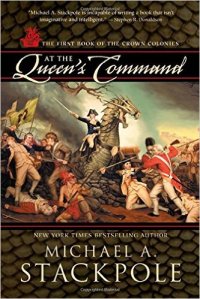I have a thing for licensed fiction. There’s something about crafting a well-written story within an already defined and structured universe that makes it seem like more than half of your work is done for you, its true. And yes, the fan-boy rocks do occasionally fly. But I imagine contributing a piece to a much larger canon still feels worthwhile, and may even be more satisfying if its a license you love.
Michael Stackpole has made a career out of this. And a very lucrative career at that.
A life-long RPG nerd, my first contact with Mr. Stackpole came in the form of the beloved Rogue Squadron series, a set of four incredibly fun novels featuring Wedge Antilles (Please remember him from the first movies. If you don’t I’ll feel old) and the elite pilot team interspersed through out the trilogy, the literary canon, and several memorable video game titles. At the time of their release (mid-late 1990’s) Star Wars was hitting a bit of a renaissance with the much-anticipated release of volumes 1-3. We all know how that went. No need to walk across that particular bed of shattered dreams here.
We’re on the cusp of yet another Star Wars theatrical renaissance here in 2015, and it looks like the results might be a bit better this time around. My only hope (rimshot) is some of the top-notch Star Wars books may get an injection of interest, and Stackpole’s name should be at the top of the list. Hence, this recommendation. He’s also written books in Battletech, World of Warcraft and Shadowrun settings as well, all very fantastic and good reads.
He’s not just a nerd putting words on paper, however. Stackpole has a talent for developing interesting and in-depth characters, or in many cases accurately expanding upon characters you already know. Three main reasons you should check out both Stackpole’s licensed work and his original inventions, both graphic and prose:

- Characters – Hands down he creates or expands on some of the best protagonists and antagonists in science fiction history. Even fan favorites liked Wedge Antilles take on a life of their own in Stackpole’s narrative. They feel real, flawed, and interesting without sacrificing any of the cool we love so dearly.
- Fantastic Detail – This guy can paint a picture with his words. A key asset for any science fiction writer, he manages to create and describe unique settings and established ones with equal precision. The galaxy far, far away in Rogue Squadron and the fantastic pseudo-America from Crown Colonies both feel equally real and tangible
- Fun – The plots aren’t overly complicated, the twists and turns aren’t exactly hidden or unexpected. He lets the characters come to the forefront and drive the story, and takes the reader along with them. Sometimes, that simple, straightforward text is just what we need for a 350-page vacation from the real world.
I like Stackpole a lot. Between Rogue Squadron and Battletech he wrote some of the coolest stories I read as a burgeoning sci-fi nerd. I’m a bit older now and realize his books don’t exactly stack up to Gatsby or War & Peace, but that’s ok. He’s an enjoyable read when you want to spend some time away from reality.
Signing Off.


